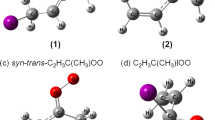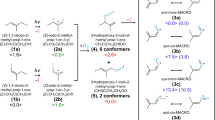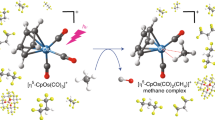Abstract
ALTHOUGH earlier work had suggested that the species methylene, CH2, could participate in “insertion” reactions into C—H and C—Cl bonds1,2, it has recently been shown that in the gas phase reaction of methylene with methyl chloride the course of reaction is best described by a radical abstraction–recombination mechanism3,4. It was shown that both ethane and dichloroethane appeared at rates at least as great as the rate at which ethyl chloride (the true “insertion” product) was formed in the reaction. The electronic state of the methylene may, however, determine the reaction path, and there is some evidence that it is excited singlet methylene which undergoes the insertion reaction5,6. Methylene is most conveniently prepared by the photolysis of ketene7 or diazomethane8, and the proportion of triplet (ground state) and singlet methylene formed depends on the precursor and the wave-length of the radiation used for photolysis9,10, more singlet being formed at shorter wavelengths. We wished to investigate the effect of change of excess energy in methylene on the course of reaction, and we present here preliminary results.
This is a preview of subscription content, access via your institution
Access options
Subscribe to this journal
Receive 51 print issues and online access
$199.00 per year
only $3.90 per issue
Buy this article
- Purchase on Springer Link
- Instant access to full article PDF
Prices may be subject to local taxes which are calculated during checkout
Similar content being viewed by others
References
Frey, H. M., and Kistiakowsky, G. B., J. Amer. Chem. Soc., 79, 6373 (1957).
Frey, H. M., J. Amer. Chem. Soc., 80, 5005 (1958).
Bamford, C. H., Casson, J. C., and Wayne, R. P., Proc. Roy. Soc., A, 289, 287 (1966).
Hassler, J. C., Setser, D. W., and Johnson, R. L., J. Chem. Phys. (submitted for publication).
Richardson, D. B., Simmons, M. C., and Dvoretsky, I., J. Amer. Chem. Soc., 82, 5001 (1960).
Duncan, F. J., and Cvetanovic, R. J., J. Amer. Chem. Soc., 84, 3593 (1962).
Norrish, R. G. W., Crone, H. C., and Saltmarsh, O. D., J. Chem. Soc., 1533 (1933).
Norrish, R. G. W., and Kirkbride, F. W., J. Chem. Soc., 1477 (1933).
Shih-Yeng Ho, Unger, I., and Noyes, W. A., J. Amer. Chem. Soc., 87, 2297 (1965).
Carr, R. W., and Kistiakowsky, G. B., J. Phys. Chem., 70, 118 (1966).
Knox, K., Norrish, R. G. W., and Porter, G., J. Chem. Soc., 1477 (1952).
Author information
Authors and Affiliations
Rights and permissions
About this article
Cite this article
JOHNSTONE, R., WAYNE, R. Effect of Excess Energy on the Reactivity of Methylene. Nature 211, 1396–1397 (1966). https://doi.org/10.1038/2111396a0
Issue Date:
DOI: https://doi.org/10.1038/2111396a0
Comments
By submitting a comment you agree to abide by our Terms and Community Guidelines. If you find something abusive or that does not comply with our terms or guidelines please flag it as inappropriate.



